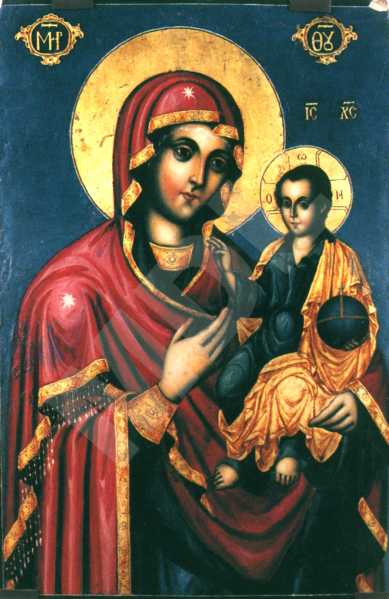The Virgin Hodegetria
Type:
Icon
Period:
The beginning of the
19 century
Toma Vishanov-Molera, born around 1750, painter of icons and murals, founder of the Bansko school of art. He grew up in the family of the clergyman Vishan. Around 1765 he went to Vienna, where he studied painting. It is not known who were his teachers there or when he returned to Bansko. His fellow villagers called him the Moler, Molera(from German Maler ‘painter’), whence the entire family's surname. Under the influence of the European 18th century art Toma Vishanov painted his works in a new manner, unknown until then in Orthodox art. The figures are realistic, vivid, expressive. Toma Vishanov is an innovator in the early period of Bulgarian Renaissance. His ideas on art were not understood and at first were rejected by his contemporaries. His work has not been studied extensively. He died after 1811 in Bansko.
Dimmensions (cm):
67
/ 46
/ 3
Location
Country: Bulgaria
Province: Blagoevgrad
Town: Bansko
Museum: Museum complex
Source
Country: Bulgaria
Province: Blagoevgrad
Village: Osenovo
Church: St. Archangel Michael
Description
The Holy Mother of God is represented in the traditional version. Her head is slightly bent to the young Christ, whom she is holding up whit her left arm. Her right arm, bent at the elbow and with an open palm, is brought in front of the chest and is pointing at him. The Mother of God is portrayed to the waist. Christ is painted in a seated position. In his left hand he holds an orb (a symbol of authority), and with his right arm, bent at the elbow he is blessing.
Iconographical technique: Combined
The painting is made after the "classic" manner of icon-painting: distemper, with an increased content of oil in the vehicle. The basic tones are laid evenly and like a cover. The modelling is achieved by means of an additional whitened tone and intensely brightened brilliancies. The transitions from the lighted to the shaded parts are accomplished extremely smoothly by means of the "wet into wet" technique of painting. The lines are clear and categorical. All carnations in the icon are painted finely with a thinly applied paint. Laid on the faces and on the hands is an orange-red paint with which they attain a certain tactile value. The varnish covering is heavily soiled, studded with spots of wax and paraffin and blackened with smoke from candles which had been burning near the icon.
Base material: Wood
The base is a softwood panel, machine processed. It had been strengthened additionally by means of two inserted beams. The ground coat is of plaster about 0,6 mm thick.
State, restoration traces and comments
The aureole of the Holy Mother of God is with a silver cover. Her hand, as also the aureole of the young Christ, had also been silver-covered, but the covers are missing. As proof of this are the holes from the pulled-out nails at the respective places. There are no signs of any previous restoration work.


